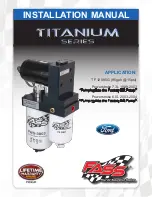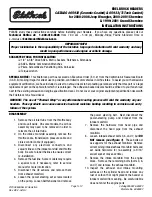
2011 Chevrolet Municipal Vehicles Technical Manual
aIr bags faq
| 13
can the installation of push bumpers on the front end of the
vehicle affect the deployment of the air bag?
General Motors is not aware of adverse effects during crash events from the many
push bumpers that have been installed on GM police vehicles. Because there are
many styles of push bumpers available with varying crash characteristics, installation
of push bumpers may or may not affect deployment timing of the air bags. Push
bumpers should be mounted to avoid modifying the vehicle structure and interfering
with the front air bag sensors mounted on the upper radiator support cross member.
Two front impact sensors are installed in General Motors vehicles. Do not relocate or
disconnect the front sensors. The location and orientation of the front sensors are
critical for correct operation of the air bag system. Avoid mounting components on or
near the sensors. Push bumper styles with vertical pushing members that are in fore-
aft alignment with the front air bag sensors are not recommended.
How long will the air bag remain inflated?
It takes approximately 1/20th of a second to fully inflate the frontal air bags. This is
faster than the blink of an eye. The air bags begin to deflate immediately, helping to
stop the occupants more gradually.
can the air bag system be re-used?
No. The air bags are designed to inflate only once. After inflation some new parts
will be required. These will include the air bag module and possibly other parts. (A
competent service technician with access to the vehicle’s service manual and the
required tools should replace the required components after a deployment crash.)
I’ve heard that the dusts that are released into the passenger
compartment from the air bag are harmful. Is this true?
For most people, the only effect the dusts will produce is some irritation of the throat
and eyes, and that is only if the occupant remains in the vehicle for many minutes
after the air bag deployment with no ventilation and windows closed. However, some
people with asthma may develop an asthmatic attack from inhaling the dusts. If this
happens, they should first treat themselves the same way their doctor has advised
them to treat any other asthma attack, and then immediately seek medical
treatment.
when should an air bag inflate?
The driver’s and right-front passenger’s frontal air bags are designed to inflate in
moderate to severe frontal or near-frontal crashes. But they are designed to inflate
only if the impact speed is above the system’s designed "threshold level."
In addition, if your vehicle has "dual stage" frontal air bags, these air bags tailor the
amount of restraint according to crash severity. For moderate frontal impacts, the air
bags inflate at a level less than full deployment. For more severe frontal impacts,
"dual stage" frontal air bags deploy at full levels.
If the front of your vehicle goes straight into a wall that doesn’t move or deform, the
threshold level of the reduced deployment is about 12 to 16 mph (19 to 15 km/h),
and the threshold level for a full deployment is about 18 to 24 mph (29 to 28.5
km/h). The threshold level can vary, however, with specific vehicle design, so that it
can be somewhat above or below this range.
If your vehicle strikes something that will move or deform such as a parked car, the
threshold level will be higher. The driver’s and right-front passenger’s frontal air bags
are not designed to inflate in rollover, side impacts, or rear impacts, because inflation
would not help the occupant.
Seat mounted side impact air bags are designed to inflate in moderate to severe side
crashes. The side impact air bags will inflate if the crash severity is above the
designed "threshold level." The threshold level can vary with specific vehicles design.
The side impact air bags are not designed to inflate on frontal or near-frontal impacts
or rear impacts, because inflation would not help the occupant.
Roof rail mounted head-curtain airbags are designed to inflate in moderate to severe
side crashes. In addition, certain vehicles have head-curtain air bags which are also
designed to inflate in situations where an impending rollover condition is identified
by the vehicle’s rollover sensing system and/or frontal or near-frontal impacts if the
crash severity is above the designed “threshold level”.
Safety belt pretensioners at the driver and front passenger seat positions are
designed to deploy in frontal, near-frontal, side, and rear crashes that exceed the
“threshold level” of crash severity to help reduce slack in the safety belt. Safety belt
pretensioners will also deploy in impending rollover situations.
I’ve heard that a deployed air bag produces what appears to be
smoke. Is the air bag hot?
After the bag has deployed in a crash, the air bag itself will not be hot to touch. Some
components within the air bag module will be hot for a short time. A small amount
of smoke coming from a deployed air bag module is normal and should not be cause
for concern.
Also, when the nitrogen gas is vented out of the air bag, small particles from inside
the bag are also vented into passenger compartment. These airborne particles look
like smoke and some particles are deposited as residue on and around the air bag.
If my vehicle has air bags, why should I have to wear my safety
belt?
Air bags are in many vehicles today and will be in most of them in the future. But
they are supplemental systems only; so they work with safety belts - not instead of
them. Every air bag system ever offered for sale has required the use of safety belts.
Even if you’re in a vehicle that has air bags, you still have to buckle up to get the most
protection. That’s true not only in frontal collisions but especially in side and other
collisions.
Head curtain side air bags are designed to help reduce the risk of head and neck injuries to front and rear seat occupants on the near side of certain side-impact collisions. Always
use safety belts and the correct child restraints for your child’s age and size, even in vehicles equipped with air bags. Children are safer when properly secured in a rear seat. See
your vehicle Owner’s Manual and child safety seat instructions for more information.





































